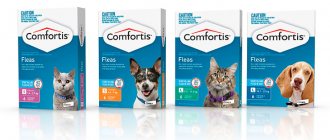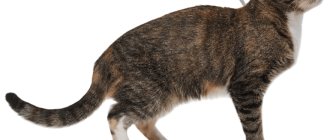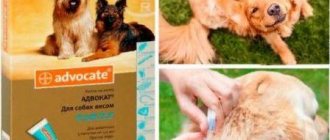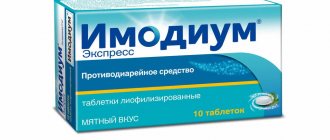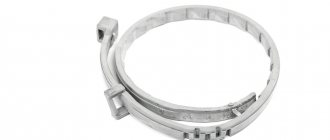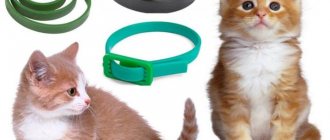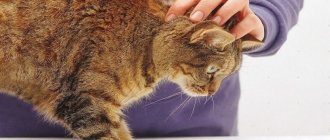Today we propose to pay attention to methods of combating insects that parasitize pets. This article will discuss various remedies: tablets against ticks and other parasites for cats and Comfortis dogs, drops on the withers, folk remedies, etc. Along the way, we will familiarize you with the instructions for using each drug and precautions for use.
Choosing a flea treatment for cats
Many cat owners are often faced with the problem of choosing an antiparasitic agent. How to choose the right flea drug and what criteria should be followed?
Basic criteria for choosing an anti-flea drug:
- high efficiency not only against mature individuals, but also larvae;
- long lasting result;
- low degree of toxicity;
- Possibility of use by kittens, pregnant and lactating cats;
- affordable price;
- ease of use;
- minimal risk of adverse reactions;
- availability on the shelves of domestic veterinary pharmacies and pet stores;
- low degree of absorption (absorption, dissolution) of the drug into the pet’s bloodstream.
The following dosage forms of antiparasitic drugs can be found on the veterinary drug market:
- drops on the withers;
- collars;
- sprays for external use;
- solutions for injections;
- shampoos;
- external powders;
- oral tablets.
Video: Anna Polumysnaya, veterinarian, about antiparasitic drugs
Risk factors
With the onset of spring, blood-sucking insects become more active. Among the most dangerous are ticks, the bite of which leads to serious health consequences and sometimes death. The high activity of ticks in the warm season is explained by the peculiarities of their life cycle and reproduction.
| READ MORE: “Habitats, external signs, features of development and behavior of the tick” “How the infection process occurs” |
The following types of ticks are common in dogs:
- Ixodes tick (ticks of the genus Ixodes carry many infectious diseases, including Babesiosis);
- Scabies mite (mites of the genus Sarcoptes scabiei form “burrows” in the skin of pets, most often inhabiting less hairy parts of the body)
- Subcutaneous mite (Demodex mites grow excessively inside the hair follicle, leading to baldness and purulent skin lesions);
- Ear mites (mites of the genus Otodectes cynotis are the cause of otitis externa).
Types of ticks dangerous to dogs - risk factors and symptoms
Parasites live outside and inside dogs and usually go unnoticed by owners. There are many types of ticks, fleas and worms that are dangerous to dogs. These parasites have one thing in common - sooner or later their presence can lead to health problems or discomfort. In addition to dogs, many parasites can also harm their owners, especially children.
Tablets as a remedy for fleas
Oral forms of antiparasitic drugs are a fairly new type of medication for cats. The active substances of these products, entering the pet’s digestive tract, are quickly absorbed into the general bloodstream and distributed throughout the soft tissues. As soon as a flea feasts on the blood of an animal, inevitable death awaits it. First of all, the nervous system of the parasite is affected, which leads to muscle atrophy, tremors and death. The therapeutic effect after using the medicine lasts about a month. A single dose of the drug is usually calculated depending on the weight of the animal.
From the animal’s body, 80% of the active substance is excreted in the urine after two days; the body is completely cleared of the drug after 7–10 days.
Taking tablet forms of the antiparasitic drug leads to disturbances in the functioning of the nervous system, tremors and further death of the flea
Possible side effects and contraindications
Usually the tablets are well tolerated by animals; side effects are possible in case of individual intolerance or the dose is exceeded. Manifest in the form:
- decreased activity, lethargy, apathy;
- Digestive problems - loss of appetite, vomiting or nausea.
In general, these drugs are safe for pets, but there are still some contraindications:
- pregnancy and lactation;
- systemic diseases;
- weakened body, old age;
- age up to four months;
- pathology of the nervous system, epilepsy;
- simultaneous use of other medications (in some cases, consultation with a veterinarian is required for clarification).
Table: brief overview of flea tablets
| Trade name of the product | Active composition | Distinctive features of the drug | Contraindications | Possible complications | Possibility of use in pregnant and lactating cats | Possibility of use in kittens | Storage conditions | Estimated cost | Country of Origin |
| Comfortis | Spinosad | Round chewable tablets of yellow-brown and brown color. | Individual intolerance to the components of the drug. | If the dosing rules are followed, no adverse reactions are observed. Overdose symptoms:
| Use under veterinary supervision. | Do not use on kittens under 14 weeks of age. | Shelf life: 3 years. Store in a dark place at a temperature of 5°C-7°C. | 6 tablets - 4000 rubles. | USA |
| Capstar | Nitenpyram | Chewable tablets that do not have a long-lasting residual effect. The active substance leaves the pet’s body within a day. | Modern science knows no cases of adverse reactions. | May be used under the supervision of a veterinarian. | Do not use on kittens less than one month old. | It is recommended to store drugs in a dark place at room temperature. | 6 tablets - 1700 rubles. | USA | |
| Lufenuron | Hormone lufenuron | After taking the drug, it takes a long time to achieve a therapeutic effect. Effective against parasite larvae and eggs, less effective against adult parasites. |
| Approved for use after consultation with a veterinarian. | Prohibited for use on kittens under 14 weeks of age. | 1 tablet - 600 rubles | USA |
Photo gallery: antiparasitic tablets
Capstar is not used on kittens younger than 4 weeks of age.
Comfortis is contraindicated in cats with hypersensitivity to the components of the drug
Lufenuron is a hormone-containing antiparasitic drug for cats.
Purpose
Anti-tick tablets for dogs are used for both prevention and treatment:
- acarosis caused by ixodid, sarcoptoid, psoroptoid and demodectic mites (more than 20 varieties);
- entomosis caused by fleas;
- from intestinal parasites (helminths, nematodes, microfilariae, etc.).
Prescription of anti-tick tablets for dogs
Table: pros and cons of flea tablets
| Advantages | Flaws |
When using oral medications, there is no need to limit the animal's contact with children, and you can bathe your pet at any time. |
|
We picked up our pet on the street. He was very dirty and his body was infested with fleas. All the skin was covered in wounds and ulcers that were scratched until they bled. Naturally, we did not dare to treat ourselves and went to the veterinary clinic. The doctor recommended Comfortis oral flea tablets. But he immediately warned that we would have to work hard to find a drug. As it turned out, these tablets were not available either in veterinary pharmacies or in online stores. We had to wait about a week for it to be delivered to us. One tablet was enough for the pet’s body to be completely cleansed of parasites. The cost of the drug fully justifies its quality. At the moment, for the purpose of prevention, 4 times a year we use a more budget-friendly option - drops on the withers.
Prevention measures
To prevent a cat from becoming infected with fleas, preventive measures are needed:
- regularly carry out wet cleaning, thoroughly vacuum furniture and carpets;
- treat animal bedding and toys with disinfectants;
- limit the interaction of cats with street animals;
- periodically bathe the cat with a special shampoo;
- You can place herbs near the pet’s place: wormwood, sage, chamomile;
- use a collar or drops for preventive purposes in the summer, when the pet is taken to the countryside or into nature.
Fleas on cats are a common and unpleasant occurrence. But don’t panic, they are easy to get rid of with the help of special means. If you use them according to the instructions and follow the advice of the veterinarian, your pet will be healthy.
Safety rules when using the drug
When using insecticidal preparations, it is necessary to follow the rules of personal hygiene and safety precautions. After finishing working with the medicine, you should wash your hands thoroughly with soap.
For people with individual intolerance to the components of the veterinary drug, it is best to use sterile gloves. If adverse reactions occur, you should consult a doctor.
Empty boxes, blisters, and bottles of veterinary medications must be disposed of along with the trash. They cannot be used for household purposes.
How to treat bedding, carpets, furniture?
It is convenient to use sprays and aerosols to treat the room. Use a spray bottle to spray the cat's bed, corners of the room and all places where the cat could leave fleas. Bedding and clothes are thoroughly washed at the highest temperatures; if the fabric allows, they are boiled.
In a cat's house or box, you can put a sachet with aromatic herbs that repel insects: wormwood, geranium, lavender. If the cat was bathed in a decoction of wormwood or hellebore water, then you can wash the floors and walls with these liquids, and wash home rugs in them. Essential oils of geranium, eucalyptus, cedar, and lemon repel ectoparasites. You can spray the corners of rooms and furniture with them.
General information
The tablets are classified as insecticides; they differ fundamentally from each other in composition and the active substance used (fluralaner, afoxolaner, spinosad, milbemycin, sarolaner, etc.)
Each active substance has its own purpose. According to the direction of action, the active substances work to destroy internal parasites living in the gastrointestinal tract and/or to destroy external parasites living on the skin (fleas, ticks, etc.)
Manufacturers produce these drugs based on the weight and age of the pet. Based on this, the appropriate dosage and frequency of use are selected.
The territory where the pet lives is also taken into account; the number of ticks in each specific region or locality may differ significantly, etc.


